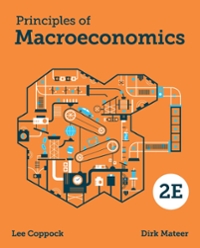Question
ECN211 Macroeconomic Principles Assignment 3 - Real-World Application of Economic Concepts (10 points) Below is a summary from the Wall Street Journal article Surging Inflation
ECN211 Macroeconomic Principles Assignment 3 - Real-World Application of Economic Concepts (10 points)
Below is a summary from the Wall Street Journal article "Surging Inflation Has Workers Demanding Higher Raises. Could It Lead to a Wage-Price Spiral?" by David Harrison and Sarah Chaney Cambon, December 21, 2021.
The COLA is making a comeback.
Higher prices, a worker shortage and a revitalized labor movement are bringing about the return of pay increases tied to inflation, known as cost-of-living adjustments, or COLAs. On Tuesday, striking workers at food maker Kellogg Co. ratified a contract that included a COLA, the second major labor agreement in recent weeks to feature such pay adjustments. Analysts say COLAs could spread in future negotiations between employers and unions. Under a COLA, a worker's pay rises to compensate for the increase in consumer prices. The idea is to protect wages in times when consumer prices are rising rapidly and unpredictably. The provisions were often part of union contracts 40 or 50 years ago when inflation was high. Starting in the 1990s, as inflation slowed to more modest levels, COLAs became less prominent. Now, resurgent inflation is leading some workers to ask for higher wages. Annual inflation in November accelerated to 6.8%, the Labor Department reported, the fastest in 39 years. Economists and Federal Reserve officials have acknowledged they don't know how high inflation will get nor how long it will last. Such uncertainty could make COLAs more attractive, said Harry Katz, an economist at Cornell University specializing in labor relations. "COLAs exist not primarily because inflation is higher, it's because there's uncertainty about inflation," he said. The provision "provides a way of basically sharing the risk." COLAs thus offer one avenue through which workers could be protected from the surging cost of living. But COLAs could also themselves contribute to inflation. Raising wages to compensate for higher prices could lead to a situation in which companies raise prices to recoup higher wages, which causes workers to ask for yet higher wages, causing the two to feed off each other. This is called a "wage-price spiral".
"While understandable from the point of view of workers, the danger of widespread use of COLAs is they institutionalize inflation and contribute to a wage-price spiral," said Michael Walden, professor emeritus at North Carolina State University. Such a wage- price spiral emerged in the 1970s and was broken only by tighter monetary policy, Mr. Walden said. A wage-price spiral could reoccur if the Federal Reserve doesn't raise interest rates significantly more than it has signaled, he said. Some economists see less reason to worry. COLA clauses were only a small contributor to higher inflation in the 1970s and 1980s, which was propelled by other factors including oil crises, said Mr. Katz, the Cornell economist. Further, a much smaller share of workers is in a union today, and COLAs are rarer, reducing the likelihood of a wage-price spiral, Mr. Katz said. Roughly 6.3% of private sector workers belonged to a union last year, down from 16.8% in 1983, according to the Labor Department. Last month, members of the United Auto Workers at Deere & Co. ended a five-week strike by ratifying a contract that, among other pay and benefit increases, would adjust wages every three months to match inflation. Tuesday's five-year contract between Kellogg and the Bakery, Confectionery, Tobacco Workers and Grain Millers International Union gives employees pay raises and quarterly cost-of-living adjustments. The agreement means that roughly 1,400 union members who had been on strike since Oct. 5 will go back to work. Union members aren't the only workers getting pay increases tied to inflation. Minimum-wage workers will see pay increases reflecting the higher cost of living in several states including Arizona, Colorado, Maine, Minnesota, Montana, Ohio, Washington, and South Dakota, according to an analysis by the National Conference of State Legislatures. In Arizona, for example, minimum-wage workers will see their hourly pay rise 5.3% to $12.80 at the start of next year from the current $12.15. The minimum wage rose 1.3% at the beginning of this year, reflecting lower inflation at the onset of the pandemic.
A shrunken labor force, combined with a strong demand for labor, has given workers greater bargaining power. That could prompt more unions to ask for COLAs. A number of major union contracts expire next year, including between West Coast dockworkers and the companies that operate marine terminals. The International Longshore and Warehouse Union declined to comment.
After reading the summary above, answer the following questions.
1. What are the three measurement problems associated with the Consumer Price Index (CPI)? 2. What are some of the differences between the Consumer Price Index and the GDP deflator? 3. Explain in your own words what a COLA is. According to the article, "the COLA is making a comeback". Briefly explain why. 4. From the abstract above, which workers got/will get the COLA in recent months? 5. What is a wage-price spiral? How can a COLA lead to a wage-price spiral? Why are economists not that concerned about a wage-price spiral in the current inflationary situation?
Step by Step Solution
There are 3 Steps involved in it
Step: 1

Get Instant Access to Expert-Tailored Solutions
See step-by-step solutions with expert insights and AI powered tools for academic success
Step: 2

Step: 3

Ace Your Homework with AI
Get the answers you need in no time with our AI-driven, step-by-step assistance
Get Started


